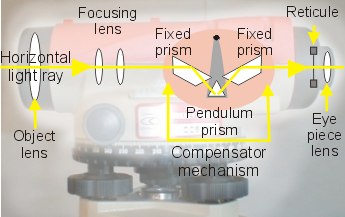Principle of the Automatic Level
The aim of this tutorial is to describe the basic principle of an automatic level.
The Automatic Level
 It
is essential that the sight line through the telescope is exactly horizontal.
If not errors will occur. One solution to this problem is the automatic
level.
It
is essential that the sight line through the telescope is exactly horizontal.
If not errors will occur. One solution to this problem is the automatic
level.
The automatic level has a compensator mechanism that uses a combination of fixed prisms or mirrors and a moving prism suspended on a pendulum to give a horizontal reference. When correctly set up the compensator will ensure that the ray of light through the centre of the reticule is exactly horizontal.
Design of the compensator mechanism varies with each manufacturer, so the diagram above is intended to show the principle of the method, not a specific instrument.
Not shown in the diagram is a damping mechanism to stop the pendulum from continuing to swing when the instrument moves. The quality of the damping mechanism is very important; too little damping will give an unsteady image which may blur in windy conditions, but too much damping may lead to errors if the pendulum does not respond to slight movements of the instrument.
The reticule is a glass plate with fine cross hairs engraved to provide the height reference. The eye piece should be adjusted to bring the reticule into sharp focus. The internal focussing lens is then controlled by the focussing screw on the side of the instrument to bring the staff image in to focus on the reticule.